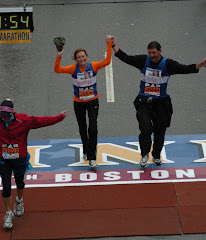
As we come up on the 126th running of the Boston
Marathon in a little over a week, the pressing question on everyone’s mind is “What’s
the appropriate behavior of a spectator at a marathon?” Well, maybe not everyone’s mind, or for that
matter anyone’s. In case you find
yourself motivated to attend a race, as someone who has run a few marathons, I can
offer a bit of an insider’s perspective on etiquette and how to be a supportive spectator.
If for some
strange reason you find yourself planning to stand for hours on the side of the
road waiting to try and pick out a runner in a crowd of thousands, so you can
shout a few words of encouragement or offer some sustenance in the few seconds
they blow by you, bless your soul. There’s
a special place in the afterlife for you.
But if you plan to put out this
kind of effort it is good to know the do’s and don’ts of being a good
spectator. This is especially true for
the Boston Spectators who have honed the practice over decades and feel that it
is their right (no, their duty) to set you right on what you are doing wrong.
Signs
Before we
talk about appropriate signs, I’d like to point out how helpful signs can
be. Comedian Bill Engvall said it best
in his routine about stupid people where he proposes that stupid people should
carry a sign so you lower your expectations when dealing with them. His routine on why Preparation H has a
warning on the packaging that says DO NOT EAT, had me in tears. It’s online, I highly recommend watching it.
A sign
saying something stupid like “Only 24 miles to go” or “One foot in front of the
other” are not only unhelpful, they reflect poorly on you in front of thousands
of runners passing you by, not to mention the spectators around you.
Signs like “Go
Daddy Go”, and “You have this Uncle Dave” have the personal touch that offer
great encouragement, while the same un-personalized messages from a stranger,
not so much. Anyone with a “Go Faster”
sign should be burned at the stake.
The best
signs are the ones with humor or backed by enthusiasm. Most notable in this category are the woman
at Wellesley college who set up the scream tunnel. Not only can you hear them screaming a half
mile before you get there but they have great creative signs like “kiss me I’m
Irish”, “be my first kiss”, “I know CPR and mouth to mouth”. There
are videos of this online, definitely worth a watch. I’ve been known in the past to have thrown a
few kisses to the women. Unfortunately,
with Covid the mouth-to-mouth personal interaction has been curtailed a lot but
the scream tunnel is still the best spectator part of the race.
Of course,
signs aren’t limited to the spectators, the runners get into the act with messages
on their clothes. Some are aimed at
other runners, particularly on the backs of their shirts. “I spit
to the right”, “I may be slow but I’m ahead of you”, and on a pair of shorts “stop
looking at my butt and run” are both creative and helpful. Other messages are for the crowd like putting
your name on your shirt or the charity your running for. The crowd does pick up on these and will add
some personalization to their cheering.
Having done this, I can say I have mixed feelings. It can be tiring towards the end of the race
to keep looking into the crowd to see if the person calling your name is really
someone you know. A bit of history, the
old days (the 1970’s), when I first started running Boston, the Boston Globe
published the names and numbers of all the runners and spectators would try to
spot your number, look you up and personalize their encouragement.
Other
interactions to keep in mind:
-
Lying
to a runner is a violation punishable by being staked out in front of the
starting line and stomped to death by thousands of runners. Saying things like “you’re at the top of Heart
Break Hill” when you are not or “one mile to go” when there is two or more, are
notable examples. Saying” you are
looking good” is excusable as a form of encouragement. Looking good is not likely or high on the
list of priorities.
-
Runners
love upbeat music.
-
Hours
of ringing cow bells or blowing horns are not bloody helpful to either the
runners or the spectators around you.
-
Offering
runners food or drinks is very generous but don’t shove them in their face or
run along side with repeated offers. One of the best gifts I received was a popsicle
at mile 22 on a 90-degree day. Jellybeans
are my favorite but I even partook in a sip of beer from a college student one
year.
-
Don’t
ask the runner to stop to take a picture.
It’s understandable that if you
are standing in the sun or cold for hours that you want to get a picture of the
person you are supporting, but don’t take it personally if they blow you off to
keep running.
-
Don’t
spray water on the runners. I know this
sounds obvious but on hot days some people bring hoses to the street to help
cool the runners. There may be times
when this is helpful to some runners but it’s the runner’s choice, not the
spectator. Wet shoes and socks are
heavier and can contribute to blisters. One
year it was so hot the Boston Marathon was almost cancelled, but instead the
race director set up cold misting spray tents on the side of the course and you
could just run through the tent and keep going. I
have to say, despite the wet shoes it was awesome.
-
Lastly,
and this is the most important, don’t ask if they are in pain or want to
stop. If they are anywhere past the 15-mile
mark they are tired, likely in pain and fighting mentally to keep going. Of course, they want to stop (Bill Engvall
would say “here’s your stupid sign”), but the spectator’s job is not to tempt
them to quit but to encourage them to keep going. Any
spectator who says “keep going, pain is just a state of mind” should get a knee
to the groin to help to put them in the right “state of mind”.
With my
marathon challenge coming up in the next week I can honestly say I’ll miss the Boston
spectators, even the inappropriate ones.
Even I get tired of my own company and spending hours in my own head is
a scary place. A screaming tunnel and
maybe a few rowdy spectators yelling encouragement would be welcome. Instead, I’ll be avoiding deer jumping out of
the woods in front of me, dodging pickup trucks on the narrow country roads and
cursing the incessant steep hills that make up my neighborhood in
Charlottesville. But when the going gets tough I’ll remember all
the people who are supporting my efforts and those pediatric cancer patients
benefiting from Help in the Nick of Time.
Wish me
luck!


No comments:
Post a Comment